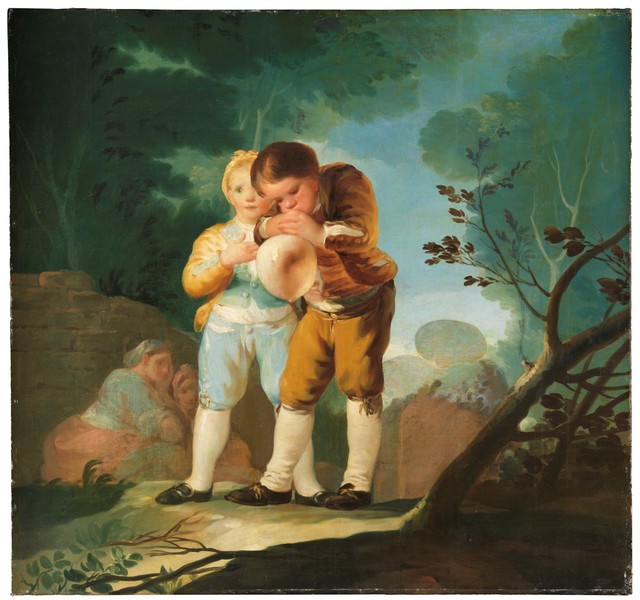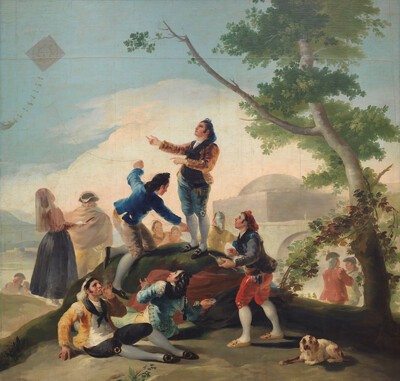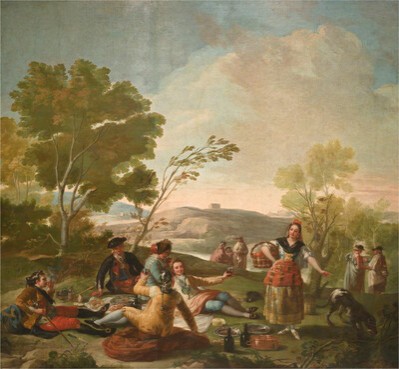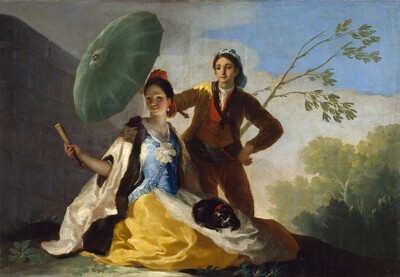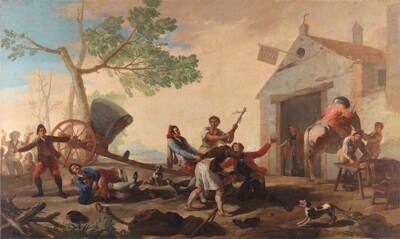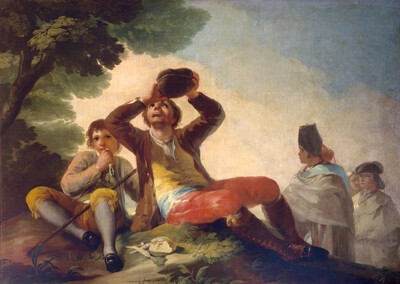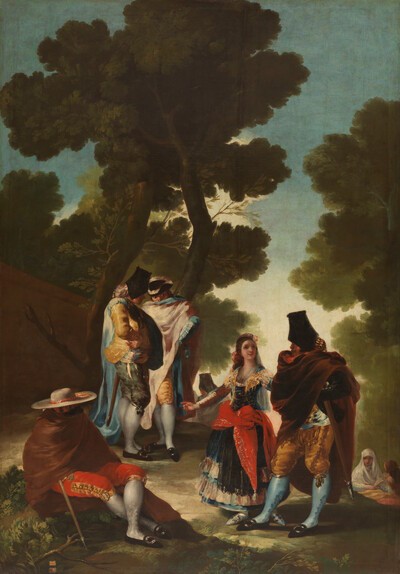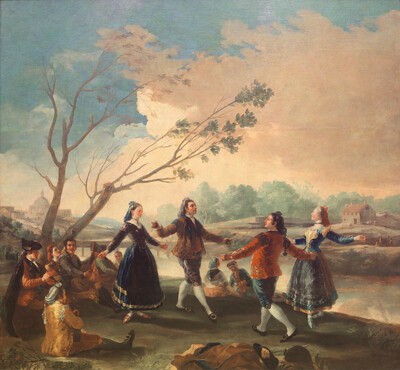- Cronología
- 1777 - 1778
- Ubicación
- The Prado National Museum. Madrid, Madrid, Spain
- Dimensiones
- 116 x 124 cm
- Técnica y soporte
- Oil on canvas
- Reconocimiento de la autoría de Goya
- Documented work
- Titular
- El Prado National Museum
- Ficha: realización/revisión
- 17 Nov 2009 / 14 Jun 2023
- Inventario
- (P00776)
- Otros títulos:
-
Muchachos inflando una vejiga
See The Kite.
The tapestry resulting from this cartoon was to hang over the north door of the dining room and formed a pair with that of Boys Picking Fruit.
As pointed out by Tomlinson, the scene may have been inspired by the print La vessie by Philippe Le Bas (Paris, National Library), based on the painting by David Teniers. The subject of children's games serves as a counterpoint to the main cartoons starring adults, The Kite and Card Players, and, continuing with the symbolism of vanitas, this work appears to aim to counteract the concerns of the grown-ups, the uselessness and futility of their science and their gambling, with the carefree play of children.
This is one of Goya's earliest representations of children, a topic which he would later become known for thanks to his ability to depict them with great realism, candour and tenderness, his skill already evident in the face of the boy waiting to tie the knot in the bladder.
Because of its pastel colours and the subject matter of games and the wind, Cruzada Villaamil saw a close relationship between this cartoon and that of The Kite. Just like the children have fun blowing up the bladder until it bursts, the adults delight in the flying of a kite, as ephemeral and passing as the wind.
Further away in the distance, on the left, we can see two women. The more visible of the two is the one sitting on the left-hand side, with her head resting on her hand in a gesture of melancholy. Tomlinson has interpreted this figure as a sibyl, confirming the fleeting nature of childish fun and the inevitable passage of time. Other writers, including Morales, are of the opinion that Goya was simply representing a traditional scene of children at play.
On the right there were initially two labourers wearing wide-brimmed hats to protect themselves from the sun. Although they appear in one of the tapestries, they have disappeared from the painting after being rather clumsily painted out. Weavers at the Royal Tapestry Factory were almost certainly responsible, wishing to make their job easier, since other tapestries exist in which these two figures do not appear.
-
Goya and his timesThe Royal Academy of ArtsLondon1963cat. 66cat. 46
-
GoyaPalacio de PedralbesBarcelona1977from April 12th to June 30th 1977cat. 5
-
Panorama de la pintura española desde los Reyes Católicos a GoyaPalacio del Concejo DeliberanteBuenos Aires1980organized by Ministerio de Cultura de Españapág, 134
-
Pintura española de bodegones y floreros de 1600 a GoyaMuseo Nacional del PradoMadrid1983consultant editor Alfonso E. Pérez Sánchez, November 1983 to January 1984cat. 37
-
GoyaLa Lonja, Torreón Fortea y Museo Pablo GargalloZaragoza1992consultant editor Julián Gállegocat. 6
-
Goya. 250 AniversarioMuseo Nacional del PradoMadrid1996consultant editor Juan J. Luna. From March 29th to June 2nd 1996cat. 15
-
Tapices y cartones de GoyaPalacio RealMadrid1996organized by Patrimonio Nacional and Sociedad Estatal Goya 96 at the Palacio Real, Madrid, consultant editor Concha Herrero Carretero. May to June 1996cat. 9
-
Goya en Madrid. Cartones para tapices 1775-1794Museo Nacional del PradoMadrid2014p. 299
-
L'œuvre peint de Goya. 4 volsParís1928-1950vol. I, p. 68, cat. 9
-
Tapices de GoyaMadridPatrimonio Nacional1946pp. 104, 215, cat. 18 y láms. 82-83
-
Vie et ouvre de Francisco de GoyaParísOffice du livre1970p. 86, cat. 83
-
BarcelonaPolígrafa1970vol. I, p. 246, cat. 72
-
L’opera pittorica completa di GoyaMilanRizzoli1974pp. 94, 95, cat. 78
-
Francisco de Goya, 4 vols.ZaragozaCaja de Ahorros de Zaragoza, Aragón y Rioja1980-1982vol. I, p. 90 y p. 124 (il.)
-
Francisco de Goya, cartones y tapicescol. col. "Espasa Arte"Espasa Calpe1987pp. 83-85, 152, 260, cat. 22C y p. 86 (i
-
Francisco de Goya. Los cartones para tapices y los comienzos de su carrera en la corte de Madridcol. col. "Ensayos de Arte Cátedra"MadridCátedra1987pp. 84-87 y p. 83 (il.)
-
Goya. 250 AniversarioMadridMuseo del Prado1996pp. 294-295, cat. 15 y p. 85 (il.)
-
Salas del Palacio Real de El Pardo para las que se tejieron tapices sobre cartones de Francisco de Goya: identificación de las habitaciones y ajuste de las obras de Goya en los alzados de las paredesin HERRERO CARRETERO, Concha (curator, Tapices y cartones de Goya (catalogue of the exhibition organizated at the Palacio Real de Madrid, from may to june 1996)MadridPatrimonio Nacional, Goya 96, Lunwerg1996p. 166 (il.)
-
Goya en Madrid. Cartones para tapices 1775-1794MadridMuseo Nacional del Prado2014p. 299
